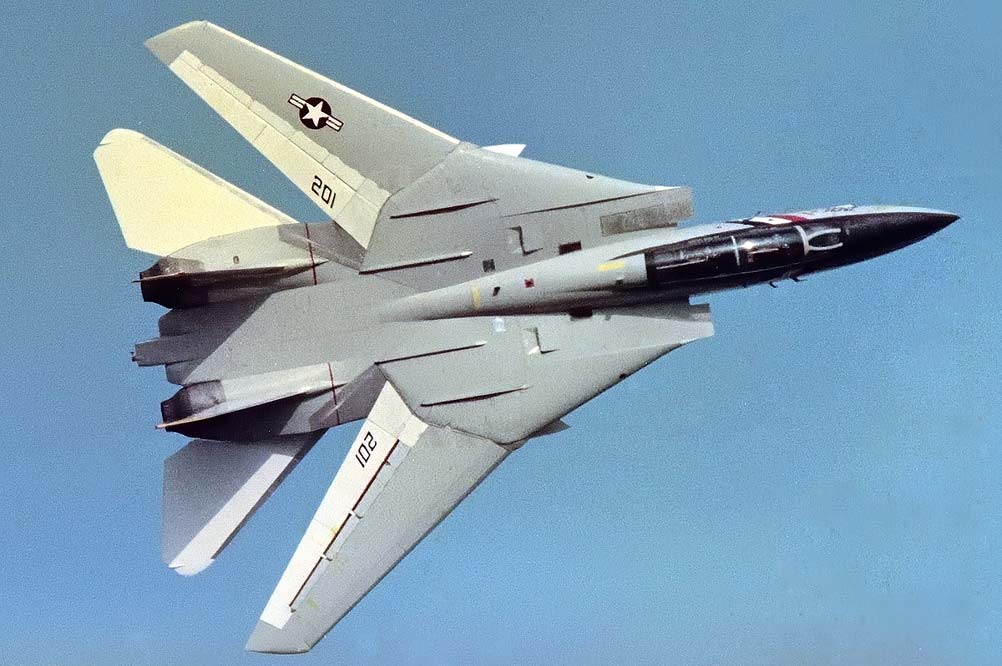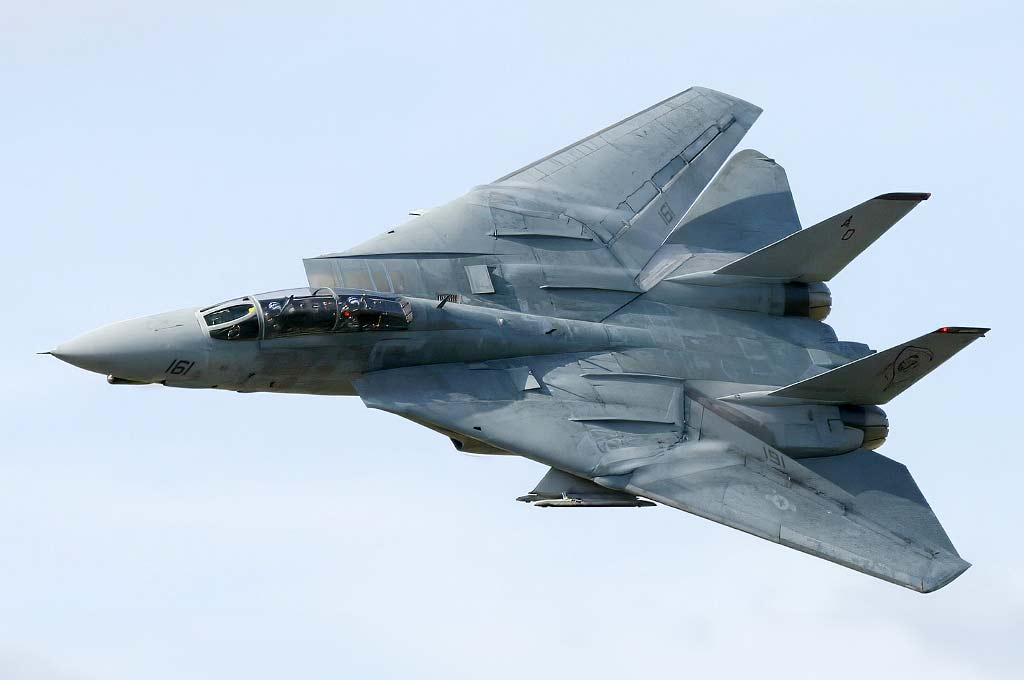Iconic US Navy air superiority fighter with variable-sweep wings, twin-engine, and Mach 2+ capabilities.
In brief
The Grumman F-14 Tomcat, a supersonic, twin-engine, two-seat, variable-sweep wing fighter aircraft, was developed for the United States Navy’s Naval Fighter Experimental (VFX) program in the late 1960s. Its primary missions were air superiority, fleet defense, and precision strike against ground targets. The F-14 featured sophisticated avionics, including the AWG-9 radar system capable of tracking up to 24 targets simultaneously and engaging six with AIM-54 Phoenix missiles. It first flew on December 21, 1970, and entered service in 1974, becoming one of the most iconic fighter jets of the Cold War era, with a top speed of over Mach 2.34, a range of 1,600 nautical miles, and a service ceiling above 50,000 feet.

The Grumman F-14 Tomcat fighter jet
The Grumman F-14 Tomcat, developed in response to the challenges faced by the US Navy in the Vietnam War and the emerging threats from Soviet aircraft, represented a leap forward in air combat capabilities. Designed to protect carrier battle groups from hostile aircraft and missiles, it filled the gap left by the retirement of the F-4 Phantom II and the cancellation of the F-111B project.
History of the Development
In the context of the Cold War and the need for a superior air-to-air combat capability, the US Navy launched the VFX program in the late 1960s. The objective was clear: develop a fighter that could dominate the skies, equipped with the latest radar and missile technology to ensure fleet defense against any adversary. Grumman’s proposal was selected, leading to the birth of the F-14 Tomcat, which first flew in 1970. This aircraft was needed to counter advanced Soviet fighters and missiles threatening US naval forces. The program’s success was not just in producing a capable aircraft but also in signaling technological and tactical advances in naval aviation.
Design of the Grumman F-14 Tomcat
The F-14’s design incorporated several groundbreaking features, including its variable-sweep wings, which allowed for excellent performance across a wide range of speeds and mission profiles. Its twin-engine configuration provided redundancy and reliability, essential for operations over vast ocean areas. The F-14 was equipped with the powerful AWG-9 radar, enabling long-range engagement of targets with AIM-54 Phoenix missiles, a capability unrivaled at the time. Despite its strengths, the Tomcat was not without drawbacks. Its complexity and maintenance demands were high, and its initial versions were plagued with engine reliability issues. However, its design allowed for significant upgrades over its service life, enhancing its capabilities and reliability.
Performance of the Grumman F-14 Tomcat
The F-14 Tomcat’s performance was a significant factor in its success. Capable of speeds over Mach 2.34 (1,544 mph, or 2,485 km/h) and a range of 1,600 nautical miles (2,960 km), it could operate at altitudes above 50,000 feet (15,240 meters). Its twin Pratt & Whitney TF30 engines in early models and later the more powerful and reliable F110-GE-400 engines provided the thrust needed for its exceptional performance. The aircraft’s ability to carry a mix of air-to-air missiles, including the AIM-54 Phoenix, AIM-7 Sparrow, and AIM-9 Sidewinder, along with a 20 mm M61A1 Vulcan cannon, made it a formidable adversary. Compared to its contemporaries, such as the Soviet MiG-29 and Su-27, the F-14 excelled in range, payload, and avionics, though each had its own advantages in different aspects of air combat.
Variants of the Grumman F-14 Tomcat
The F-14 underwent several upgrades throughout its service life, resulting in various variants. The initial F-14A model was followed by the improved F-14B (upgraded engines) and F-14D Super Tomcat (further avionics and engine upgrades). Each variant enhanced the aircraft’s performance, reliability, and capabilities, with the F-14D representing the peak of the Tomcat’s development, incorporating modern avionics, improved engines, and better overall performance and reliability.

Military Use and Combat of the Grumman F-14 Tomcat
The F-14 saw extensive use in various conflicts, most notably in the 1980s and 1990s. It played a critical role in US Navy operations during the Gulf War, enforcing no-fly zones and conducting precision strikes. Its most famous engagement was the 1981 Gulf of Sidra incident, where two Tomcats engaged Libyan Su-22s, underscoring the F-14’s superiority in air-to-air combat. The Tomcat was also sold to Iran before the 1979 revolution, where it saw combat during the Iran-Iraq War, achieving notable success against Iraqi aircraft.
In US Navy Service
During the Gulf War, the F-14 played a pivotal role in Operation Desert Storm and its preceding operations. As part of the coalition forces aimed at expelling Iraqi troops from Kuwait, F-14s conducted reconnaissance missions, using their sophisticated sensors to gather crucial intelligence on Iraqi movements and fortifications. They were also tasked with enforcing no-fly zones over Iraq, ensuring Iraqi aircraft did not violate the airspace restrictions imposed by the coalition. The F-14’s ability to carry a mix of AIM-54 Phoenix, AIM-7 Sparrow, and AIM-9 Sidewinder missiles made it a formidable air-to-air platform, capable of engaging enemy aircraft at long ranges.
One of the most highlighted engagements of the F-14 was the 1981 Gulf of Sidra incident. This confrontation arose from a territorial dispute over the Gulf of Sidra, claimed by Libya as its territorial waters. US Navy F-14s from the USS Nimitz were engaged by Libyan Su-22 Fitter aircraft. In the ensuing engagement, the Tomcats shot down two Su-22s, demonstrating the F-14’s air combat superiority and its pivotal role in projecting US naval power.
Service with the Iranian Air Force
The F-14 Tomcat also saw significant action with the Iranian Air Force, where it was introduced before the 1979 Islamic Revolution. Iran was the only foreign country to which the F-14 was sold, receiving 79 aircraft. During the prolonged and brutal Iran-Iraq War from 1980 to 1988, the F-14s were deployed extensively in air-to-air combat roles. Iranian Tomcats were particularly effective against Iraqi combat aircraft, including MiG-21s, MiG-23s, and Mirage F1s. The F-14’s advanced radar and missile systems allowed it to engage and destroy enemy aircraft at ranges where the opponents could not retaliate, a significant advantage in the vast airspace over the Persian Gulf and the Iranian-Iraqi border.
Iranian F-14s were reputed to have been highly successful in air combat, claiming numerous Iraqi aircraft with the AIM-54 Phoenix missile, the long-range air-to-air missile exclusively used by the F-14. These engagements underscored the aircraft’s capabilities in air superiority roles and its contribution to Iran’s defense strategy during the war.
The F-14 was officially retired from US Navy service in 2006, replaced by the F/A-18E/F Super Hornet, but it left a lasting legacy as one of the most iconic and capable fighter aircraft ever built.
–
The Grumman F-14 Tomcat remains a symbol of American air power and technological prowess. Its development and operational history reflect the Cold War era’s challenges and the continuous evolution of aerial combat tactics and technology. Despite its retirement, the Tomcat’s legacy continues through its impact on naval aviation and air combat doctrine, setting a high standard for future fighter aircraft development.
Back to the Fighter Jet section.
Read more:
The F-14 Tomcat, a fighter born out of failure and naval urgency
The variants of the F-14 Tomcat: an evolution in three acts, stripped of all myth